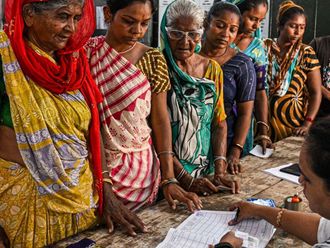We posed for the camera with our best smiles. But we never said “cheese” but “monkey”, the new catchword used by the photographer to make us smile.
Our four-member family had gone to a photo studio. It was one of those rare occasions when all four of us, me, my better half and our adult children — were together. The studio was simple, with a table and chairs and a big screen. One of the walls was covered with photos — of cherubic babies smiling angelically, of couples looking into each others’ eyes adoringly, of siblings holding hands or hugging each other, of entire families cheerfully grouped together. This was how they wanted to be remembered. Happy, close-knit, oozing love and togetherness.
These portraits are taken with high-definition cameras, not the shutterbugs of the past. And they’re far more casual than the “posed” photos of yesteryears.
But somehow, the black-and-white photos of the past seem to have made a resounding comeback. Many of the prized images mounted in the studio are black-and-white beauties, the whites and light greys in sharp contrast to the darker hues. They spring out at you and immediately grab your attention, much more so than the bright hues of a colour photo.
And we all have those prized black-and-whites of the past: family heirlooms carefully preserved in musty albums. It is ironic that in this age of the digital camera, we neither have the time nor the inclination to ever look through the pictures we take, all faithfully stored on our computer or on a flash drive. But those old albums?
We never ever grow tired of carefully turning each page, gently lifting the gossamer-thin semi-transparent cover that protects the photo, and gazing lovingly at a picture of our grandparents on their wedding day, or our mum and dad as children sitting astride a wooden rocking horse. Each photo is lovingly mounted with sticky triangles on all four corners that hold it to the page.
The album usually has thick black paper from which the photos stand out all the better. (What is it about the paper and the glue of the past? Why is it that we can’t make them like they did in those days?)
If there’s one thing that’s strikingly different between the photos of the past and today’s, it’s the way a husband and wife pose. Many of us have those old photos where the man is seated royally on a sofa or an elaborate chair almost like a throne, while his wife subserviently stands beside him.
Sick of surfeit
Of course, this was the trend in those days, and it’s a big question about how “subservient” those women really were, but at least for the camera they followed the rules. Not any more, though. You’d probably see the reverse these days, with the woman seated and the man standing. Just goes to show how far women have come!
Why have professionally taken photographs, either in a studio or in your home or other location, become so popular despite all of us, including 8-year-olds, owning a smart phone? I think we are just “sick of surfeit”, of the hundreds and thousands of badly taken, slapdash photos that lie in our mobile phones. The fact that it has become so easy to take a photo has led to this cloying excess. It’s gotten worse as people upload an entire reel of their visit to the beach or their latest holiday onto Facebook, and expect us to view all 54 of them!
This is where a visit to a professional photo studio comes in. Isn’t quality better than quantity? That’s a lesson we’ve learnt from the past. And yes, I now have a photo, elegantly framed and mounted, of all four of us grinning widely. The catchword used was not “cheese” or “monkey” but “sausages!”
Padmini B. Sankar is a Dubai-based freelance writer.









